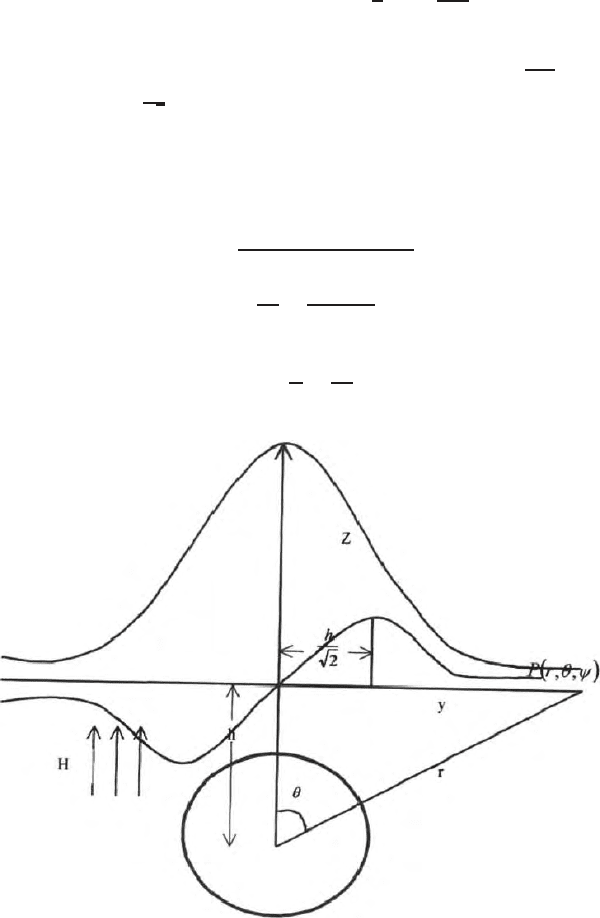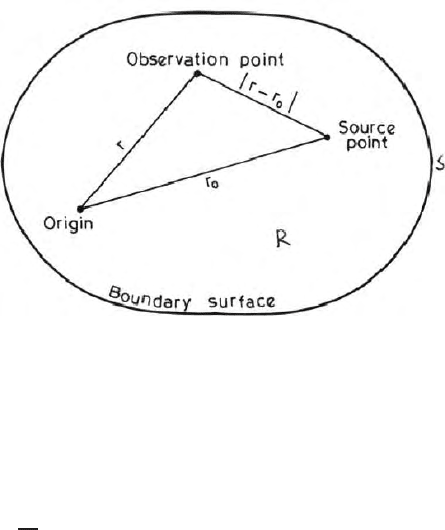Roy K.K. Potential theory in applied geophysics
Подождите немного. Документ загружается.


13.11 Sphere in the Field of a Vertically Oscillating Magnetic Dipole 439
It is assumed that µ = µ
0
.
Since
I
′
3/2
(α)=I
1/2
(α) −
3
2α
I
3/2
(α)
I
1/2
(α)=
2
πα
1/2
sin hα
and
I
3/2
(α)=
2
πα
1/2
cosh α −
1
2
sin hα
,
d
1
canbewrittenintheform
d
1
= −
1
2
.Ha
3
asinhα − (2γ +1)
cosh α −
1
α
sin hα
α sin hα +(γ − 1)
cosh α −
1
α
sinh α
= −
1
2
Ha
3
α
2
− (2γ +1)(α coth α −1)
α
2
+(γ −1) (α
2
coth α −1)
= −
1
2
Ha
3
S. (13.418)
Hence
A
0
=
1
2
Hr sin θ −
1
2
H
a
3
r
2
S sin θ (13.419)
H
r
= H cos θ − H
a
3
r
2
S cos θ (13.420)
(normal field) ↓ (perturbation field) ↓
H
θ
= −H sin θ −
1
2
Ha
3
r
2
.S sin θ (13.421)
(normal field) (perturbation field)
If we take M = −
1
2
Ha
3
S, the radial and angular components are
H
r
=
2
Mcosθ
r
3
,
H
θ
=
Msinθ
r
3
(13.422)
The effect of a sphere is as if a dipole is oriented along the Z-axis and it is
placed at the centre. We can express the vertical and horizontal components
as
H
z
=
H
r
cos θ −
H
θ
sin θ (13.423)
=H−
1
2
Ha
3
S
−
1
r
3
+
3h
2
r
5
(13.424)

440 13 Electromagnetic Wave Propagation
where
r
2
=y
2
+h
2
(13.425)
and
H
y
=
H
r
sin θ +
H
θ
cos θ = −
1
2
Ha
3
S.
3hy
r
5
. (13.426)
Here the vertical field is only the normal component and it will be maximum
at y = 0 and the horizontal component will be maximum i.e.,
∂H
y
H
will b e
maximum at y = ±
h
√
2
(Fig. 13.18). Hence the anomaly field depends upon
the S and geometry of the body.
HereS=M+iNwhereMandNarerespectively the in phase and quadra-
ture components.
Now for smaller values of ‘α’
S=−
3α (coth α −1) −α
2
α
2
(13.427)
=1+
3
α
2
−
3cothα
α
. (13.428)
Since
coth α =1+
α
3
−
α
3
15
+ ....., (13.429)
Fig. 13.18. Variation of horizontal and vertical magnetic field over a buried sphere-
ical inhomogenities

13.12 Principle of Electrodynamic Similitude 441
Fig. 13.19. A conducting plate of radius a and thickness t
the approximate value of S
S ≈
α
2
15
=
1
15
α
2
ωµσ.
For a spherical body, the multiplication factor to α
2
ωµσ is
1
15
instead of
1
8
in
the case of an infinitely long cylinder. For a circular plate of finite diameter
and thickness the response factor is
2
15
at ωµσ whereaistheradiusofthe
plate and t is the thickness (Fig. 13.19).
The frequency response for all bodies (conductive or resistive) can be writ-
ten as |F| =kL
2
ωµσ where k is the multiplication factor.
13.12 Principle of Electrodynamic Similitude
From Maxwell equations cur l
E = −μ
∂
H
∂t
,andcurl
H = σ
E+ ∈
∂E
∂t
,
div
μ
H
=0,div
∈
E
= 0 where there is no source in the region. Let
l
0
and t
0
represent the unit of length and time. ∈
0
,μ
0
,e
0
and h
0
are the cor-
responding units of electrical permittivity, magnetic permeability, electric field
and magnetic field. We can then write l = l
0
l
′
,t= t
0
t
′
,E= e
0
E
′
andH =
h
0
H
′
. Curl has the dimension of 1/l ength. We can then write from Maxwell’s
first equation.
e
0
l
0
.Curl
′
E
′
= −
μ
0
t
0
.μ
′
.h
0
.
dH
′
dt
′
(13.430)
Here curl is a pure number.
From Maxwell’s second equation we get,
h
0
l
0
.Curl
′
H
′
= σ
0
σ
′
e
0
E
′
+
∈
0
∈
′
t
0
e
0
∂E
′
∂t
. (13.431)
we can write from (13.430) and (13.431)
.Curl
′
E
′
= −
μ
0
l
0
t
0
.
h
0
e
0
.μ
′
∂H
′
∂t
′
(13.432)
and
curl H
′
= −
σ
0
l
0
e
0
h
0
.σ
′
E
′
+
∈
0
l
0
t
0
.
e
0
h
0
. ∈
′
∂E
′
∂t
. (13.433)

442 13 Electromagnetic Wave Propagation
From t hese two equations, we can write
μ
0
l
0
t
0
.
h
0
e
0
. = constant k
1
(13.434)
μ
0
l
0
t
0
.
h
0
e
0
. = constant = k
2
and
∈
0
l
0
e
0
t
0
h
0
= constant = k
3
. (13.435)
Since the Maxwell’s equations are valid, these factors will be constants. From
these three equations, we can write
μ
0
.l
0
.h
0
t
0
e
0
.
∈
0
l
0
.e
0
t
0
h
0
=k
1
xk
2
=K
1
(13.436)
μ
0
.l
0
.h
0
t
0
e
0
.
∈
0
l
0
e
0
t
0
h
0
=k
1
xk
3
=K
2
(13.437)
Thus
μ
0
σ
0
l
2
0
t
0
. = constant and
μ
0
∈
0
l
2
0
t
2
0
= constant.
From t hese two equations, we can write
1.
μ
0
f
0
σ
0
l
2
0
= constant (13.438)
and
2.
μ
0
f
2
0
∈
0
l
2
0
= constant (13.439)
These are two basic equations of the electrodynamics similitude. Usually the
displacement current will be significant when the frequency is of the order of
10
6
. That is in the megahertz range frequency, both the equations must be
satisfied for any kind of model simulation. For geophysics, where the operating
frequency is in the audio frequency range, the displacement current is negli -
gible and only one equations must be satisfied for simulation of models i.e.,
μ
0
σ
2
0
f
0
h
2
0
= constant. Thus l
2
wμσ is the electromagnetic response parameter
and is used in geophysical exploration. If M stands for the model and F stands
for the fields data, then
μ
M
σ
M
w
M
L
2
M
= μ
F
σ
F
w
F
L
2
F
(13.440)
where μ, σ, w , and L are respectively the magnetic permea b ility, electrical
conductivity, angular frequency and linear dimension of the model. When we
simulate the electgromagnetic model for non magnetic materials,
μ
M
= μ
F
= μ
0
and the (13.440) reduces to

13.12 Principle of Electrodynamic Similitude 443
μ
2
M
w
M
σ
M
= L
2
F
w
F
σ
M
(13.441)
Once we set up the model for a particular s et of L
2
ωμσ = constant, we
can utilise the response function by suitably multiplying it by a constant.
In otherwords, we know responses due to a (i) sphere
1
15
a
2
wμσ
(ii) cylin-
der
1
8
a
2
ωμσ
and (iii) plate
2
15
atwμσ
, we have to find out the suitable
multiplication factor for b odies of other geometrical shapes for the relation
kl
2
wμσ.

14
Green’s Function
In this chapter we briefly discussed about some of the basic natures of Green’s
function. It is a mathematical to ol having multifaceted application in vari-
ous branches of applied mathematics and mathematical physics. Some of the
properties and applications of Green’s function in potential theory a re given.
Dyadics and dyadic Green’s functions are defined. The nature of scalar and
tensor Green’s function are shown. Application of Green’s function in math-
ematical modeling is given in Chap. 15.
14.1 Introducti on
Green’s function is a mathematical tool used to solve potential and nonpoten-
tial boundary value problems in scalar and vector potential field domain. It
can represent a potential function which is harmonic and regular maintaining
some differences in their properties with potential function at the boundaries.
In the vector potential field domain it can represent a field or a vector poten-
tial. Green function can be a tensor in the vector p otential field domain and
both scalar and tensor Green’s function can b e the kernel function in the Fred-
hom’s or Volterra,s integral equations. In the presence of a boundary surface
nearby, image of a source appears in the Green function’s formula. Green’s
functions are always associated with two points say G(r, r
0
) where r and r
0
are respectively the distances of the o bservation point and source po int from
an assumed origin in the space domain (Fig. 14.1).
These points may be within a domain R or one of the points may be
within a domain and the other point may be on the surface S which binds
the domain. This surface may be at finite distance from the source or it may
be at infinite distance. So Green’s functions are generally associated with the
boundary conditions and/or initial conditions. It is used as a mathematical
tool for solution of elliptic, parabolic and hyperbolic differential equations
(see Chap. 2) with homogeneous and inhomogeneous boundary conditions.

446 14 Green’s Function
Fig. 14.1. A green’s function domain with source point, observation point, boundary
surface and origin
It is often used in some cases for solution of Poisson and Laplace equa-
tion with homogeneous and inhomogeneous Dirichlet, Neumann and mixed
(Robin or Cauchy) boundary conditions. Once Green’s function is evalu-
ated for homogeneous equation (say Laplace equation) with homogeneous
say φ =0or
∂φ
∂n
= 0 on the boundary
boundary conditions it can be used
for inhomogeneous equations with inhomogeneous boundary conditions in
some cases.
The form, application and method of determining Green’s function vary
from problem to problem in time and space domain. It depends upon the field
where it is applied as well as on the guiding equation. It vanishes on the su r-
face of a bounded region. It can represent a potential at a point due to an unit
source. It can reduce the unknowns to be deter mined in a potential problem
Green’s function is symmetric and the principle of reciprocity is valid. Some
of the discontinuities in a potential function at boundaries are removed in
Green’s function domain. Green’s function also can have discontinuity on the
boundary. Green’s function can be used as a mathematical tool for solution of
problems related to heat conduction, electromagnetic wave propagation, em
transients initial value problems, impulse response problems etc. The proce-
dural details for evaluation of the Green’s function differ in different topics
of mathematical physics. So far as geophysics is concerned the major appli-
cation of Green’s function lies in solution of boundary value problems using
Integral Equation method where non dyadic form appears in direct current
flowfieldoranyotherscalarpotentialfield and dyadic form appears in elec-
tromagnetic field.. For solution of Laplace’s equation, we have other options
like series solution of harmonic function, method of separation of variable ,
conformal transformation etc. We need not go for Greens function for all types
of problems specially where evaluation of Green’s function may invite tougher
14.2 Delta Function 447
mathematics. For time varying EM fields, the Green’s function appear in the
form of a dyadic function generally since the scalar is replaced by a vector and
dot product appears in place of algebraic product. Dot product with a vector
source appears only if G, the Green’s function is in the form of a dyadic. Since
in vector potential domain both the field and the potential are vectors and
Green,s function can represent both the fields and vector potentials. In vector
potential domain both scalar and tensor Green’s functions co exist. Green’s
theorem has a major role in evaluating Green’s function in potential theory.
Vector Green’s function and tensor algebra have contribution towards der iv-
ing dyadic Green’s function obtained from Helmholtz electromagnetic wave
equation. It is dyadic for a vector source and nondyadic for a scalar source.
The way so me similarities exist in operations between a matrix inverse
and an operator inverse, an identity matrix and an idem factor or an iden-
tity operator in operator domain, some such similarities do exist between a
nine component second order tensor and a dyadic. A few simple examples of
determining Green’s function are given.
This topic is briefly introduced in this chapter. Further details are avail-
able in Lanczos (1941, 1997), Morse and Feshbach (1953), Blakely (1996),
Tai (1971), Stackgold (1968, 1979), Roach (1970), Sneider (2001), Macmil-
lan (1958), Sobolev (1981), Ramsay (1959), Barton(1989), Van Bladel (1968),
Hohmann (1971, 1975, 1983, 1988).
14.2 Delta Function
Dirac delta function was introduced by Paul Dirac. It states that a function
‘r’ is assumed to vanish everywhere outside the point at r = r
0
.Atthepoint
r=r
0
, the value of the function δ(x, r) becomes in finitely high such that the
total area or volume under the curve is unity. It can be expressed as
∫ δ(r −r
0
)dr=1. (14.1)
One can write
δ
ij
=1fori=j
δ
ij
=0fori= j (14.2)
where δ
ij
are the values of an identity matrix and it is known as Kronecker
delta, i.e., I
ij
= δ
ij
, where I is the identity matrix. For a multidimensional
space, we have
δ(r − r
0
)=δ(x −x
0
) δ(y − y
0
) δ(z − z
0
) (14.3)
where x, y, z are the three coordinates in an Euclidian space and the co ordi-
nates of r and r
0
are respectively (x, y, z) and (x
0
, y
0
, z
0
).
In the integral form, we have
v
δ(r −r
0
)f(r)dv =
δ(x − x
0
)δ(y − y
0
)δ(z −z
0
)f(x
0
y
0
z
0
)dxdydz (14.4)

448 14 Green’s Function
14.3 Operators
Solution of a boundary value problem is an important area in mathemat-
ical physics. It initiates the mathematical formulation of forward problems
which is a basic ingredient for solving an inverse problem needed for inter-
pretation of geophysical data. Many of the forward problems are based on
elliptic, parabolic a nd hyperbo li c type of differential equations. In some cases
these equations can be ordinary differential equations. These equations can
be written as
LΦ = f (14.5)
where L is the operator. It can be a linear or nonlinear differential opera-
tor. Φ is the unknown function to be determined and f is a known function.
Equation (14.5) can be a first, second or higher order ordinary or partial
differential homogeneous or inhomogeneous equations with homogeneous or
inhomogeneous boundary conditions. The differential operators are
L=
d
dx
(14.6)
L=
d
2
dx
2
+
d
dx
(14.7)
L=
∂
2
∂x
2
+
∂
2
∂y
2
+
∂
2
∂z
2
(14.8)
Equation (14.8) is also known as Laplace or Poisson operator for second order
partial differential equations and is denoted by ∇
2
and ∆. Using the same
operator we can write Laplace, Poisson and Helmholtz equations as
Lφ =∆φ = ∇
2
φ = 0 (14.9)
Lφ =∆φ = ∇
2
φ = f (14.10)
Lφ =∆φ = ∇
2
H=γ
2
H (14.11)
One of the methods for solving the partial differential equation is to go for
searching an inverse operator L
−1
where L
−1
L=LL
−1
=IwhereIisthe
identity operator. Since L is the differential op erator, L
−1
is termed as an
inverse integral operator. Nature of these integral operators takes the form of
Fredhom or Volterra’s integral equation. The kernel of this integral is termed
as the Green’s function for the operator L. Assuming L to be a linear o r linear
differential operator, we get
L
−1
φ(x) =
G
/
(x, x
0
)φ(x
0
)dx
0
. (14.12)
From the relation L
−1
L=LL
−1
=I,wecanwrite
φ(x) = Iφ(x) = LL
−1
φ(x) = L ∫ G
/
(x, x
0
) φ(x
0
)dx
0
⇒∫G(x, x
0
) φ(x
0
)dx
0
(14.13)
where LG
/
(x, x
0
)=G(x, x
0
)
